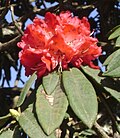| Rhododendron subg. Azaleastrum | |
|---|---|
 | |
| Rhododendron leptothrium | |
| Scientific classification | |
| Kingdom: | Plantae |
| Clade: | Tracheophytes |
| Clade: | Angiosperms |
| Clade: | Eudicots |
| Clade: | Asterids |
| Order: | Ericales |
| Family: | Ericaceae |
| Genus: | Rhododendron |
| Subgenus: | Rhododendron subg. Azaleastrum Planch. |
| Type species | |
| Rhododendron ovatum | |
| Sections | |
Rhododendron subgenus Azaleastrum is a subgenus of the genus Rhododendron . [1]
The subgenus included two sections, however in 2005, Choniastrum was elevated to subgenus rank, but sections Sciadorhodion and Tsutsusi were added, providing a new total of three sections. [2]
- Azaleastrum sect. Azaleastrum (10 species)
- Azaleastrum sect. Sciadorhodion (16 species)
- Azaleastrum sect. Tsutsusi (81 species)
